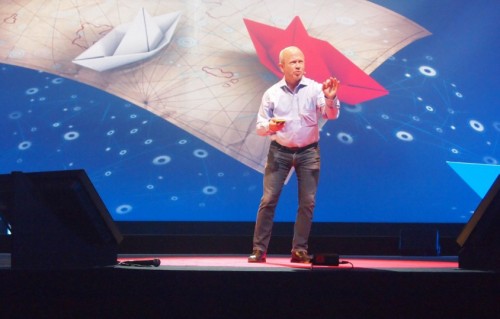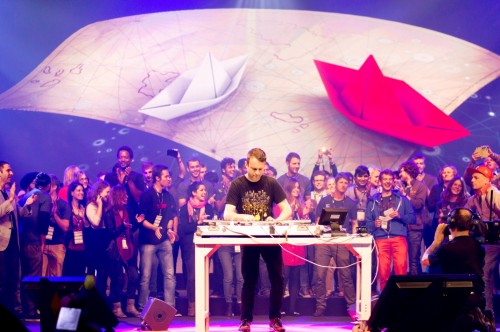
Hitting his stride – Robert P Crease in full flow at yesterday’s TEDx talk at CERN after forgetting about the timer, which is the small object at his feet. (Courtesy: Maya Elhalal)
By Robert P Crease in CERN, Geneva
It’s great to go first.
Then you can actually listen to the other performances without fretting about your own. Somewhere near the middle of my TEDxCERN talk yesterday (Wednesday 24 September) I stopped being aware of the timer at my feet, began to have fun and left the stage at the end without even noticing whether I had exceeded my time limit. I made a brief stop backstage to lose my “Madonna” – a microphone that’s not on a neck clip or attached to a headset but extends out from an ear brace – then retook my seat in the front row.
Each talk had been honed to be brief, efficient and with a punch to grab a mixed audience. I heard lots of sentences that stuck. Hayat Sindi, the first woman from the Persian Gulf’s Arabian states to complete a PhD in biotechnology, defined imagination as: “To dream what people say ‘no’ to.”
Nina Federoff, a National Medal of Science laureate, who has faced protests, verbal abuse, and nearly physical attack for explaining the science behind genetically modified organsims (that’s for explaining the science, not for actually creating GMOs or for stuffing them down infants’ throats), said: “Fear sells better than facts.”
Brazilian physicist Marcia Barbosa, speaking about the peculiar properties of the compound that covers most of the Earth’s surface and comprises most of the human body, said: “Water is weird, freaky weird.” She also compared covalent bonds to marriage and hydrogen bonds to flirting, images that may revolutionize early chemistry education.
Tamsin Edwards, about to begin a lectureship at the Open University and author of a blog called “All models are wrong…but some are useful” after a statement by the late statistician George Box, said: “Uncertainty is the engine of science.”
I framed my talk – about why science is such a weak force in government circles – around the conflict, early in the movie Jaws, between the nerdy scientist Richard Dreyfuss, who says that the mangled body that has washed up on the beach is the result of a shark attack, and the town’s mayor. Terrified by the economic impact on the town of closing the beaches, the mayor says it was surely due to a boating accident and decides to keep the beaches open. Guess what happens next!
Unfortunately, I got carried away and forgot to click my shark slide at the right moment. Damn! That was supposed to visually crystallize it all! Science (metaphorically) tells you what sharks are and their feeding habits. It’s then up to us to decide how to avoid them, but knowing the science is more helpful than shark-denial.
Many talks had what I thought of as “shark slides”, or images designed to stick. Federoff’s was a slide showing a correlation between global food price spikes and the Arab spring riots, suggesting that the real reason behind riots that destabilize governments is food shortages; it was one of the most haunting single slides I have ever seen. The Caltech materials scientist Julia Greer’s (less threatening, but also dramatic) shark slide was of four nanostructures, each smaller in diameter than a human hair, of a Tardis, Dalek and other objects from Doctor Who.
The first session concluded with a musical performance that featured identical twin sisters/singers who confounded the unclued-in audience by seeming to simultaneously disappear from one side of the room and reappear at the other side without dropping a note. To end the second session, Andrew Nemr won the boundary-crossing award when he, a Lebanese Canadian who studied ichthyology and then computer animation, and who ended his formal dance training at the age of 10, tap-danced his way through an analytic talk on the power of labels.

All together now – electronic musician Tim Exile brings the crowd not only to its feet, but up on stage. (Courtesy: Antonios Manaras, CERN)
To conclude the third and final session, the electronic music performer Tim Exile asked the audience to make an “ooommmmmmmmm” sound, then electronically mixed this with various sounds that he had recorded around CERN earlier in the day – including sounds from air-conditioning units – to create a catchy rhythmic composition that drew much of the crowd up on stage to dance.
Rumour had it that the event was originally supposed to end with a surprise guest appearance by Eric Idle, but that the comedian was unavailable because he was attending a special memorial service for Robin Williams.
No matter; the event could not have finished on a more exuberant note.
Robert, you did do a good job as you managed to keep your time and said what you were programmed to say. Well, where can one find your talk?
Trackback: Physics Viewpoint | How to give a great TEDx talk